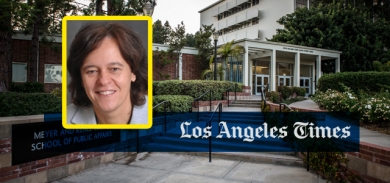Counterpoint: Alumni Perspective on ‘Informal Cities’ As a planner for Los Angeles County, Jonathan P. Bell MA UP 05 has a different view of "informal" activities like street vending and unpermitted housing.

Jonathan P. Bell
By Alejandra Reyes-Velarde
UCLA Luskin Student Writer
Last year, urban planning professors Anastasia Loukaitou-Sideris and Vinit Mukhija published their book “The Informal American City,” exploring informal activities such as unpermitted housing and street vending across the country. To the authors, informal activities require understanding and potentially legitimization, to improve living and working conditions for citizens.
But having experienced the effects of informal housing firsthand through his work as a zoning enforcement planner, Jonathan P. Bell MA UP ’05 brings a different perspective to the debate of informal housing.
In his role at the Los Angeles County Department of Regional Planning, Bell says informal housing complaints are common, leading him to investigate activities such as illegal street vending, yard sales and unpermitted home-based businesses, and even conversion of garden sheds into housing. But Bell finds the term “informality” itself to be a problem because he thinks it is a euphemism used by urban planners to mean ‘illegal.’
“The problem with the term ‘informal’ is that it softens reality of what’s actually happening with so called informal housing,” Bell says. “There’s nothing benign about uninspected and poorly built housing that’s frequently the cause of injuries or deaths. That is what’s happening in Los Angeles.”
Though he has worked closely with both Loukaitou-Sideris and Mukhija, as they both served on his capstone project committee while he attended UCLA, Bell has several critiques for the views expressed in their book. Bell says he thinks the depiction of informal housing as tidy, informal garage apartments are deceiving and make it easy to call for legalization of unpermitted dwelling units.
“People are getting hurt or killed in unpermitted housing far too often,” Bell said.“Yet the dangers of unpermitted housing are rarely discussed in the informality literature.”
A common argument for informal housing is that it provides affordable housing in Los Angeles for those who live below the poverty line or in low-income situations. According to Bell, the areas remain a poor housing option because they are unsafe and uninspected, often being priced at near market value.
Bell says he has a ‘boots on the ground’ zoning enforcement perspective, visiting local communities on a daily basis and talking to community members about their concerns and problems.
“Experiencing [informal activities] firsthand, [we] are much better prepared to propose solutions,” Bell says. “This helps us explain the gravity of the problem and the need for property owners to take responsibility to find safe and workable solutions through permitting the unsafe dwelling units.”
Finding a solution to the puzzle of informal housing demands the work of enforcement and urban planners as well as potential changes in policy. Though Bell says he thinks municipal codes and policies should be followed to ensure residents’ safety, he says one option would be to re-examine and change some municipal codes to support the development of safe and affordable housing options.
“For example, removing requirements for on-site covered parking facilities at residences could enable more legal garage conversions…along with the necessary environmental analyses and outreach strategies to explain these changes to weary communities,” he said. “But until then, we have municipal codes in place that are rooted in community health and safety. ”
Bell has written several articles and continues to write about the subject of Informal housing in the online magazine, UrbDeZine, including an interview with a UC Berkeley PhD student and his responses to counter arguments on the matter.

 Zocalo Public Square
Zocalo Public Square

